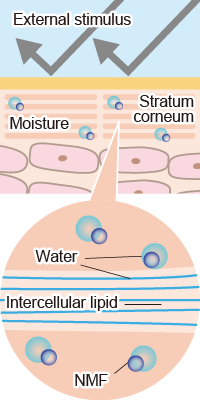
Function of The Skin
 Moisturizing Function
Moisturizing Function

It is the hydrolipid film secreted by the body that helps keep the surface of the skin moist, along with the NMF (Natural Moisturizing Factor) and intercellular lipids in the stratum corneum. The NMF and intercellular lipids are generated when the skin turnover is functioning smoothly, and ensure that the skin is kept moist by soaking the corneocyte cell layer of the skin in water. Intercellular lipids help fuse cells together and also trap water to help the skin retain moisture and prevent it from becoming dry.
 Barrier Function
Barrier Function
When the hydrolipid film and moisture balance of the stratum corneum is correct, it protects the skin and the body from the external environment. The stratum corneum of the epidermis is made from keratin, which is also used to form nails and hair. The difference between these structures is that unlike in the nails and hair, the kertin cells in the stratum corneum are rich in water and each cell is moist and soft. The effect of this moisture and intercellular lipids is to produce healthy akin that forms a barrier protecting the body.



